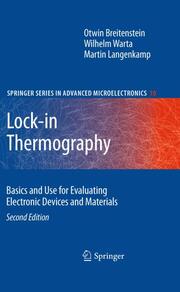Detailansicht
Lock-in Thermography
Basics and Use for Evaluation Electronic Devices and Materials - Springer Series in Advanced Microelectronics 10, Springer Series in Advanced Microelectronics 10
ISBN/EAN: 9783642024160
Umbreit-Nr.: 1427500
Sprache:
Englisch
Umfang: x, 258 S., 56 s/w Illustr., 33 farbige Illustr., 2
Format in cm:
Einband:
gebundenes Buch
Erschienen am 05.09.2010
Auflage: 2/2010
- Zusatztext
- This is the first book on lock-in thermography, an analytical method applied to the diagnosis of microelectronic devices. This useful introduction and guide reviews various experimental approaches to lock-in thermography, with special emphasis on the lock-in IR thermography developed by the authors themselves.
- Kurztext
- This book deals with lock-in thermography (LIT) as a special active dynamic variant of the well-known IR thermography. It enables a much improved signal-to-noise ratio (up to 1000x) and a far better lateral resolution compared to steady-state thermography. The book concentrates on applications to electronic devices and materials, but the basic chapters are useful as well for non-destructive evaluation. Various experimental approaches to LIT are reviewed with special emphasis to different available commercial LIT systems. New LIT applications are reviewed, like Illuminated LIT applied to solar cells, and non-thermal LIT lifetime mapping. Typical LIT investigation case studies are introduced.
- Autorenportrait
- Otwin Breitenstein studied physics at Leipzig university and graduated there in 1980. After dealing with spatially resolved capacitance spectroscopy of point defects (Scanning-DLTS) at the Institute of Solid State Physics and Electron Microscopy in Halle until 1992, he is a scientific staff member at Max Planck Institute of Microstructure Physics, Halle. His main interest field is electronic device and materials analysis by electron microscopic and IR-based methods. Wilhelm Warta studied Physics at Würzburg and then Stuttgart University, where he graduated and received his PhD with research on charge transport properties of organic molecular crystals. 1985 he joined Fraunhofer Institute for Solar Energy Systems in Freiburg starting with work on carrier lifetime measurement techniques for semiconductor materials. His fields are the development of measurement techniques for solar cell development, characterization of solar cell material and solar cells, device and process simulation as well as high precision calibration of solar cells.
